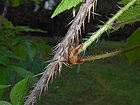Note: This is a project under development. The articles on this wiki are just being initiated and broadly incomplete. You can Help creating new pages.
Difference between revisions of "Eleutherococcus senticosus - Siberian ginseng"
(→Chemical Composition) |
(→Common names) |
||
| Line 13: | Line 13: | ||
==Common names== | ==Common names== | ||
| − | {{Common names|kn=|ml=|sa=|ta=|te=|hi=|en= | + | {{Common names|kn=|ml=|sa=|ta=|te=|hi=|en=Siberian ginseng}} |
==Properties== | ==Properties== | ||
Revision as of 17:13, 25 February 2019
Eleutherococcus senticosus is a species of small, woody shrub in the family Araliaceae native to Northeastern Asia. It is often colloquially referred to as Siberian ginseng, eleuthero or ciwujia. E. senticosus has a history of use in traditional Chinese medicine where it is known as cì wǔ jiā.
Contents
- 1 Uses
- 2 Parts Used
- 3 Chemical Composition
- 4 Common names
- 5 Properties
- 6 Habit
- 7 Identification
- 8 List of Ayurvedic medicine in which the herb is used
- 9 Where to get the saplings
- 10 Mode of Propagation
- 11 How to plant/cultivate
- 12 Commonly seen growing in areas
- 13 Photo Gallery
- 14 References
- 15 External Links
Uses
Stress, Anexity, Snakebites, Menopausal problems, Geriatric debility.
Parts Used
Chemical Composition
Dihydroxybenzoic acid, Eleutheroside[1]
Common names
| Language | Common name |
|---|---|
| Kannada | |
| Hindi | |
| Malayalam | |
| Tamil | |
| Telugu | |
| Marathi | NA |
| Gujarathi | NA |
| Punjabi | NA |
| Kashmiri | NA |
| Sanskrit | |
| English | Siberian ginseng |
Properties
Reference: Dravya - Substance, Rasa - Taste, Guna - Qualities, Veerya - Potency, Vipaka - Post-digesion effect, Karma - Pharmacological activity, Prabhava - Therepeutics.
Dravya
Rasa
Guna
Veerya
Vipaka
Karma
Prabhava
Habit
Identification
Leaf
| Kind | Shape | Feature |
|---|---|---|
| Simple | Alternate | Kirschner long 3.5-12cm, with spines or no thorns; leaflets 5, thin 4 or 3, petiole 0.5-2cm long, brown hair |
Flower
| Type | Size | Color and composition | Stamen | More information |
|---|---|---|---|---|
| Unisexual | 2-4cm long | purple-yellow | 5 | Flowers Season is June - August |
Fruit
| Type | Size | Mass | Appearance | Seeds | More information |
|---|---|---|---|---|---|
| ovoid-globose | 8 mm | styles persistent, ca. 1.5 mm. Fl. Jun-Jul, fr. Aug-Oct | With hooked hairs | single | {{{6}}} |
Other features
List of Ayurvedic medicine in which the herb is used
- Vishatinduka Taila as root juice extract
Where to get the saplings
Mode of Propagation
How to plant/cultivate
Prefers a light warm open loamy humus-rich soil and a position sheltered from north and east winds[3]
Commonly seen growing in areas
Mixed and coniferous mountain forests, forming small undergrowth or groups in thickets and edges, high forest riparian woodland.
Photo Gallery
References
External Links
- Ayurvedic Herbs known to be helpful to treat Stress
- Ayurvedic Herbs known to be helpful to treat Anexity
- Ayurvedic Herbs known to be helpful to treat Snakebites
- Ayurvedic Herbs known to be helpful to treat Menopausal problems
- Ayurvedic Herbs known to be helpful to treat Geriatric debility
- Herbs with Leaves used in medicine
- Herbs with common name in English
- Habit - Herb
- Index of Plants which can be propagated by Seeds
- Index of Plants which can be propagated by Cuttings
- Herbs that are commonly seen in the region of Mixed and coniferous mountain forests
- Herbs that are commonly seen in the region of forming small undergrowth or groups in thickets and edges
- Herbs that are commonly seen in the region of high forest riparian woodland
- Herbs








